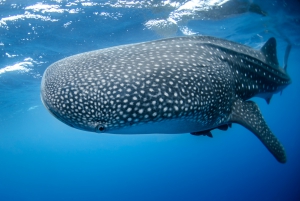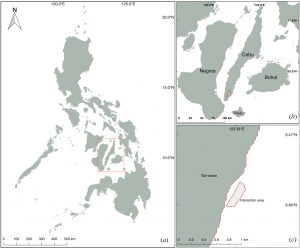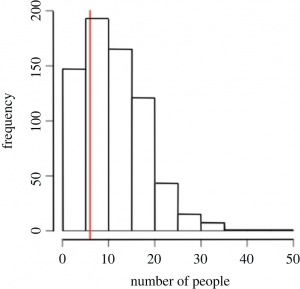Behavior modifications in whale sharks (Rhincodon typus) suggest a need for tourism management intervention
By Adrianna Davis, SRC intern
The whale shark (Rhincodon typus) is the world’s largest extant fish species (Figure 1). Whale sharks are solitary animals; however, they aggregate where there is high availability of copepods, fish eggs, and crab larvae, which are staples of the whale shark’s broad diet (Legaspi et al. 2020). The elusiveness of the whale shark contributes to its popularity with tourists. Encounters with whale sharks began in 1980s at Ningaloo Marine Park and have since been adopted in other areas where whale sharks frequent. In 2018, approximately $10 million was input into the economy by the 500,000 tourists who visited Oslob, Philippines to see whale sharks (Legaspi et al. 2020). Despite economic benefits, concerns have arisen regarding the pressure this puts on whale sharks.

Figure 1: Anterior view of a whale shark swimming at the surface (Source: NOAA 2019)
A recent study conducted by Legaspi et al. suggests that management intervention is necessary to mitigate the tourism pressure on whale sharks. The team conducted focal follow surveys in an interaction area off of the Philippines (Figure 2) from February 2015 to May 2017 to understand how external stimuli influences shark behavior. Researchers used photograph identification to record sharks’ behaviors in response to events that occurred in the survey period. The events and behaviors were previously outlined by the researchers (Legaspi et al. 2020). The collected data was analyzed using a binomial generalized linear mixed model (GLMM) to integrate variables.

Figure 2: Map of the study site in the Philippines that magnifies into the interaction area (c) (Source: Legaspi et al. 2020)
From the 358 twenty-minute surveys that were conducted, there were 692 events recorded, including 38 active touches and 301 passive touches. Violations to regulations set by the local government included 75.1% of swimmers coming within 2 m of the shark and 13.4% of at least one diver coming within 2 m of the shark (Figure 3). These events made the sharks more likely to exhibit an avoidance behavior, which was recognized by the shark diving, swimming off, rolling back its eyes, or shuddering violently (Legaspi et al. 2020).

Figure 3: Frequency of the number of people seen within 10 m of the sharks in comparison the recommended maximum of six (indicated by the red line) (Source: Legaspi et al. 2020)
The whale sharks that were observed feeding were less likely to display avoidance behaviors. This may indicate that the whale sharks learned to associate food with the site (Legaspi et al. 2020). Although the learning abilities of sharks have not been heavily studied, an experiment on small-spotted catsharks (Scyliorhinus carnicula) found that the foraging efficiency of the catsharks significantly improved when food was used for positive reinforcement techniques (Kimber et al. 2013). It is possible that whale sharks in Oslob have begun to exploit the provisions of tourist boats. One concern that arises is how non-target species will be impacted by provisioning. Studies on bait and chum input from shark cage-diving have shown that nontarget species will forage on these provisions and alter their diet (Meyer et al. 2020).
As wildlife tourism increases in popularity, the threats of overcrowding and noncompliance of visitors, as well as the implications from provisioning, will continue to negatively impact shark behavior if not properly monitored. One possible mitigation strategy is developing an assessment framework available to researchers, managers and policy makers (Meyer et al. 2021). The wellbeing of the whale shark population must be prioritized so that the species can thrive, allowing tourists to continue to have memorable experiences and local economies to thrive.
Works Cited
Kimber J.A., Sims D.W., Bellamy P.H., Gill A.B. 2013. Elasmobranch cognitive ability: using electroreceptive foraging behaviour to demonstrate learning, habituation and memory in a benthic shark. Anim. Cogn. 17:55-65. http://doi.org/10.1007/s10071-013-0637-8
Legaspi C., Miranda J., Labaja J., Snow S., Ponzo A., Araujo, G. 2020. In-water observations highlight the effects of provisioning on whale shark behaviour at the world’s largest whale shark tourism destination. R. Soc. Open Sci. 7:200392. https://doi.org/10.1098/rsos.200392
Meyer L., Apps K., Bryars S., Clarke T., Hayden B., Pelton G., Simes B., Vaughan L.M., Whitmarsh S.K., Huveneers C. 2021. A multidisciplinary framework to assess the sustainability and acceptability of wildlife tourism operations. Conservation Letters. https://doi.org/10.1111/conl.12788
Meyer L., Whitmarsh S.K., Nichols P.D., Revill A.T., Huveneers C. 2020. The effects of wildlife tourism provisioning on non-target species. Biological Conservation. https://doi.org/10.1016/j.biocon.2019.108317
NOAA, 2019. Whale shark viewing photographer [Photograph]. Unsplash.com



